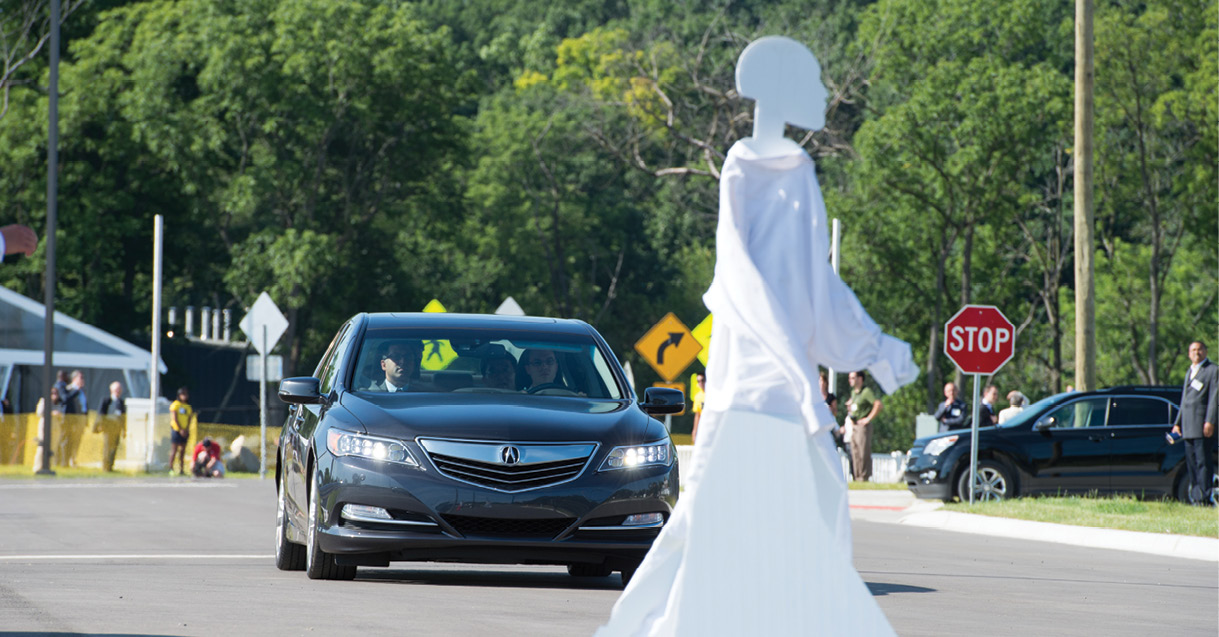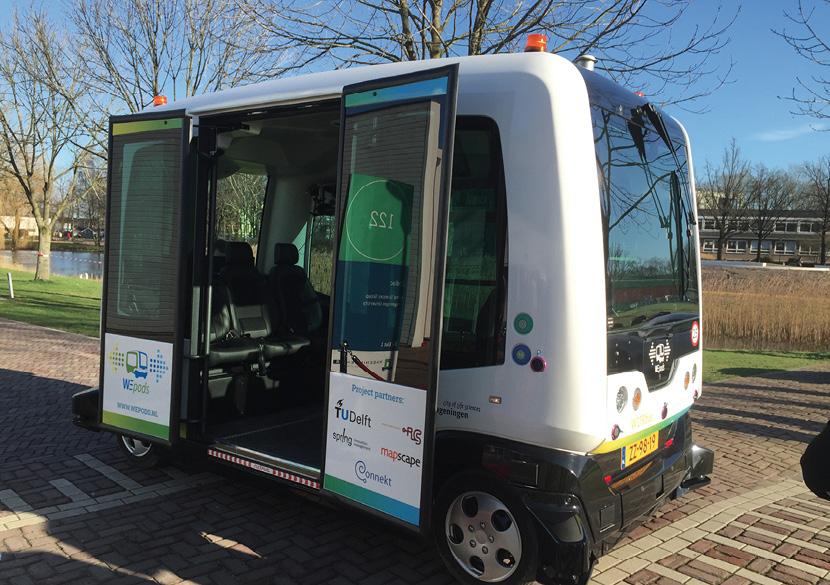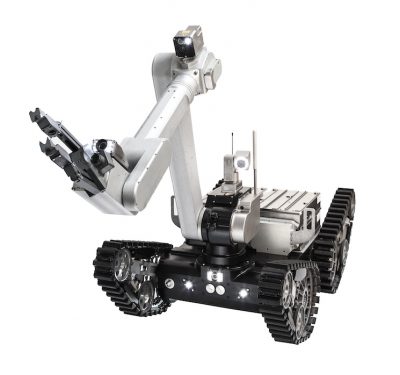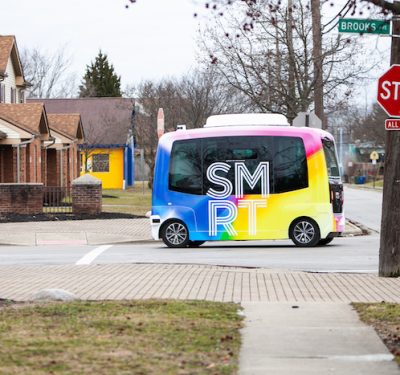
As drivers move across cities and towns or cruise along U.S. highways, most don’t think about the infrastructure that surrounds them. The stoplights, road signs and lane markings have always just been there, guiding their next move and helping keep the roadways safe.
But what happens when these cars no longer have drivers, and become instead robots that rely on constant communication to get their passengers from point A to point B without incident? If the public is to truly benefit from integrating autonomous cars the supporting infrastructure must be updated to ensure a smooth transition to a world where robots do the driving.
The U.S. Department of Transportation (DOT), other agencies and car manufacturers all recognize the need to upgrade the infrastructure but there are many unanswered questions and challenges that make this a difficult task, from how quickly fully autonomous cars will be available to public acceptance to the costs and politics associated with making the upgrades. To help, in January President Barack Obama proposed to invest nearly $4 billion over 10 years, which would fund pilot programs to test connected vehicle systems in designated corridors.
First Steps
Over the last few months, DOT has been developing deployment guidelines that outline exactly what needs to happen before automated technology, including fully driverless cars, can operate on the roadways, National Highway Traffic Safety Administration Communications Director Bryan Thomas said. They’re also working with the American Association of Motor Vehicle Administrators to develop a unified national framework for fully autonomous vehicle guidelines.
“The maturing of driverless cars and the infrastructure need to occur in parallel. A big question we face all the time is when will these vehicles be ready,” Thomas said. “How do you know when they’re safe enough to deploy, and how do you measure that safety? The other part is the technology is developing so quickly. We’re making sure the policy we develop is nimble so we can adjust over time. Our goal is to get the life-saving value driverless cars bring to the street and ensure we’re not introducing any new safety concerns.”
To do that, the major players in this evolving industry need to think about vehicle-to-vehicle communication, vehicle to infrastructure communication and the necessary infrastructure upgrades as these systems evolve, as well as a host of other challenges that must be overcome before full autonomy is a reality.

Vehicle-to-Vehicle Communication
The ability for vehicles to communicate with each other is vital to safely integrating driverless cars into roadways and highways. If vehicles can communicate, they can help each other avoid collisions, or even send out warnings about dangerous road conditions, said Greg Scharer, COO of Perrone Robotics.
“Particularly in crowded areas with a lot of vehicles, we need to increase the capacity of bandwidth on which vehicles communicate with each other,” Scharer said. “The sensors collect many megabytes of data every minute. If one car goes over slick pavement, that information could be transmitted to a near neighbor immediately and then a larger system of near traffic control. All vehicles heading that way have the information in real time.”
Through features like cruise control, automatic braking and automatic lane change, many of today’s cars already rely on information from other vehicles, said Tom Kurfess, a mechanical engineering professor at Georgia Tech and a member of The American Society of Mechanical Engineers. In those cases, sensors tell vehicles how far they are from the cars directly around them.
But vehicles will need to share information directly when driverless cars are on the roads, telling each other what’s happening as far as 10 cars ahead, Kurfess said. Once this kind of messaging is in place, if a truck slams on its brake two cars in front of you, your car will receive that information as it’s happening. This is one of the ways driverless cars can help reduce the number of car accidents and fatalities.
“The cars could basically be passing out information,” Kurfess said. “The car in front of me slows down, I pass that to the car behind me and then that information gets passed on to three to four cars after me. All of a sudden we have a warning of what’s going on down the road. So often someone slams on their brakes, the car behind them slams on their brakes and then two or three cars behind them, there’s an accident.”
Not only will these cars need to communicate, that communication will also need to be accurate. Adopting autonomous standards will help ensure communication between vehicles is clear, Scharer said. If common messaging structures are implemented, it will allow these cars to consistently report what they’re seeing to other vehicles as well as to the traffic control system—a capability that will become particularly important during the transition period when driverless cars are sharing the roadways with human drivers.
“This will be the most challenging time,” Scharer said. “The vehicles will need to communicate about other autonomous vehicles as well as human drivers, who act differently than an autonomous vehicle. There needs to be a common way of talking among vehicles and to the traffic control system.”
But a common messaging system isn’t enough. Today, every vehicle on the road has a different “brain,” Scharer said, and none of them speak the same language or behave the same way. One might break differently than another or use different actions to solve the same problems. To ensure safety, driverless cars must perform and function in the same way—and that means a common operating system.
When there’s a barrier in the roadway, for example, all cars reacting to that barrier should brake at the same g-force and stopping distance, Scharer said. They should coordinate with other vehicles to ensure they don’t collide when swerving to miss an object in the road. These cars of the not-so-distant future should have the same way of interrupting data and responding to it, which is why Scharer believes developing a common operating system is key.
Regardless of messaging styles and operating systems, vehicle-to-vehicle communication isn’t that far off. The Department of Transportation is in the process of issuing a rule that will require every new vehicle sold in the U.S. to come equipped with vehicle-to-vehicle communication capability, Thomas said. This includes being able to transmit data about the vehicle’s position, direction and speed.

Vehicle-to-Infrastructure Communication
As driverless cars make their way down the road, they also must be able to receive updates from the infrastructure, according to the Florida Department of Transportation, whether it’s to learn about a construction zone ahead or that there’s a red light at the next intersection. This is already happening on some level today, with Amber Alerts and information about traffic congestion already available. In Florida, about 98 percent of the interstate highways are equipped with fiber optics to make this communication possible.
Vehicle-to-infrastructure communication provides a huge safety benefit, said Ibro Muharemovic, head of advanced engineering North America for Continental, a company that has successfully tested automated vehicles on the roads. If the car knows there’s a construction zone coming up in a mile or two, for example, it can take another route to avoid the construction, improving traffic flow as well as lowering the risks for construction workers.
Today, every construction zone is different, Muharemovic said. Some warn drivers with a sign while others just have construction barrels—which all vary in shape and size. This adds complexity because developers must take every possible situation into account to make sure these vehicles can take the appropriate action.
“If it was communicated to our vehicle when these construction zones are going to happen in advance, we could drive a little more efficiently rather than sitting in a traffic jam,” Muharemovic said. “Pothole patching crews are another challenge. They drive up and down the highway slowly patching the potholes. If the position of the vehicle is communicated to the autonomous car, it could make maneuvers earlier rather than waiting for traffic to slow down.”
Driverless vehicles will also need to be able to read stop signs, speed limit signs and other common roadway signs, said Michele Mueller, senior project manager for connected and automated vehicles at the Michigan Department of Transportation (MDOT). Old rusted signs on the side of the road simply won’t be enough. And until the day all the vehicles on the roads are driverless, humans will still need to be able to read them, too.
While the signs we see today will likely remain on the roadways, they’ll use technologies like radio frequency ID tags to communicate with vehicles about the speed limit, Scharer said.
There are already sensors in the roads that tell drivers about traffic conditions, and Kurfess sees a future where the infrastructure will give driverless cars details about dangerous road conditions. If the road coming up is icy or slick, vehicles will be alerted so they can prepare. The vehicles will also know whether salt has been put down on icy roads, and will even be able to communicate back to the infrastructure if more salt is needed.
“The communication system has to be robust,” Mueller said. “It has to have elements of security for vehicles to use it. A large amount of information has to go over the communication infrastructure.”

Infrastructure Upgrades
Inconsistency in the roadway infrastructure is another challenge software developers face—not only around the world but also across the U.S. As you travel from state to state, you might find different sized speed limit signs or some roads with dashed lines to separate exit lanes from the rest of the highway.
This is something most drivers likely don’t notice, but it could cause problems for autonomous vehicles. These vehicles must be equipped to read every sign and detect every lane marking. Maintaining signs and robust lane markings as well as making and keeping them consistent are among the infrastructure improvements that would benefit driverless cars, Scharer said.
The quality of the roads and consistent traffic lights are also important, Muharemovic said. Most traffic lights are vertical with red on top, orange in the middle and green on the bottom. The problem comes when these lights are horizontal. Now, all three colors are next to each other, but the car’s algorithm looks for certain colors in a certain positon.
“This is very challenging for us to determine, but how do we standardize?” Muharemovic said. “We don’t necessarily have to change the layout, but if we can communicate vehicle-to-infrastructure this would help us. If the roads are in good quality, the lane markers standard and the exit and traffic signs placed in similar positions with similar meanings that would be something we could use to better our vehicles.”
As agencies like MDOT work to prepare the roads for driverless cars, they’re thinking about these very issues. For instance, once autonomous cars are on the roads, the lanes might not need to be as wide as they are now, Mueller said. As vehicles become fully autonomous, human error should dwindle as a factor in accidents. Cars will be able to travel closer together, making it possible to fit more vehicles on the infrastructure network. And while vehicles will still need an area they can pull over during emergencies, there may be less need for guardrails.
MDOT is working with auto manufacturers and suppliers in Michigan to help determine what changes must be made to make the transition to driverless cars, Mueller said. They have to look at costs and how updates will impact their funding as well as their current operations center, and what changes can be made now versus sometime in the future.
“It could be a totally different outlook when we have full autonomy in say 20 years,” Mueller said. “There are a lot of unknowns between standards and vehicle manufacturers. Our forward vision is continually fluid.”
Mapping
Autonomous vehicles need more information than human drivers, including how wide the road is, exactly where the stop line is at an intersection and the exact location of infrastructure pieces on the side of the road, said Walter Sullivan, head of Elektrobit (EB) Innovation Lab, which develops embedded software for the automotive industry. Precise positioning is key for this to work; you must be able to accurately calculate the vehicle’s position on the road. That’s why Sullivan says providing higher definition mapping is so vital.
“One of the things we think about for improved mapping information is with the sensors in the vehicle, radars, lidars and cameras, we can use those pieces to improve our understanding of the vehicle,” Sullivan said. “We use multiple sensors on the vehicle to understand where in the world the vehicle is at a very precise level. For an autonomous car we need to know within centimeters.”
Getting the level of detail required for precision mapping can be difficult, Sullivan said, and the amount of space needed to store the data grows by orders of magnitude. The cars will collect new data as they drive, and then push that data up to the cloud. The information will be used to regularly improve existing maps, and those updated maps will then be sent back to the cars. That’s an infrastructure that will take time to build out, and it will take time to generate the mapping data.
Other challenges
While many people are excited about driverless cars and the possibilities they bring, not everyone is enthusiastic about the idea. Public opinion will either accelerate or slow down the transition, said David Coher, planning commissioner in Pasadena, Calif., while regulations could also slow down the process. Not only will it take a while to implement new laws and policies that move the country toward driverless cars, but current regulations also may cause a hold up.
The physical infrastructure is a public asset, minus a few toll roads, Coher said, and these roads have very set standards. The width of the lines and signs are regimented; he even experienced problems when neighbors wanted to add speed bumps to a street that, according to state regulations, can’t have them.
“When you have regulations that are so precise as to what can and cannot occur on a block the city owns, but the city can’t choose how to use, it makes it very difficult to make these changes,” Coher said. “You have to go through the political process, which is designed to slow things down. So what I anticipate is more of the technological work arounds, which are going to be easier to develop than to work through the political process. I suspect it’s going to be more about coming up with technological solutions to the lines in the street as they are. There is demand for the product and if you need to overcome that to get to market it’s going to be easier to invest in R&D than to take the time with the lobbying required to make the changes.”
Not only that, as technologies develop, some communities might opt not to use them, maybe because of cost or simply because they don’t want driverless cars on their streets. So while some cities will make the changes, others won’t.
“If it becomes contentious, making infrastructure changes will be difficult,” Coher said. “If things go relatively smoothly infrastructure change will come quickly thereafter. Everybody will want to be part of that. Everybody will want to be an innovator and onboard. Then it will just be a funding challenge.”
The technology continues to evolve, and while it’s something car manufacturers and software developers aren’t used to, they’re going to have to come together to share information to make this a reality, Mueller said. In the driverless world, GM cars will have to talk to Ford, Chrysler and Nissan cars. Interoperability is crucial, and while companies are starting to talk and share ideas, there’s still much more that could be done.
“I hope we get to a point where it’s standardized and we have a set of messages,” Muharemovic said. “For example, construction zones, traffic lights, traffic signs all talking to us based on what’s happening on the road. But for this to happen, we have to get together and agree on some of the challenges and safety concerns of the infrastructure today.”
The future
Everyone has a different timeline for when fully autonomous cars will become a common sight on our roadways. Coher said he sees some cities ready to adopt them in the next 5 to 10 years. It will be several decades before we see any dramatic infrastructure changes, and he expects we’ll continue to recognize the roadways as they are today for at least the next 20 years.
No matter how long it takes, there are many manufacturers, academics and government leaders focused on making driverless cars a reality, and implementing the infrastructure changes that will get us there. The benefits driverless cars offer are many, from reduced traffic accidents to greater fuel efficiency and more mobility for the elderly and handicapped.
“What I do see in the future of autonomous vehicles is a very bright light for humanity because these cars will perform much safer, much more efficiently and at a much lower cost,” Scharer said. “There are nearly 40,000 driving fatalities in the U.S. every year. If we could cut that number in half or by three quarters, which I know we can, we are saving millions of people over a life time.”






